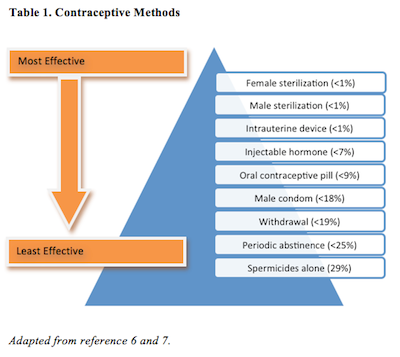Publication
Article
Pharmacy Times
Trends in Birth Control: Who Uses What?
Author(s):
Pharmacists can play a vital role in helping patients understand contraceptive methods and improve adherence.
Pharmacists can play a vital role in helping patients understand contraceptive methods and improve adherence.
The Centers for Disease Control and Prevention acknowledged the development of effective contraceptive methods as one of the top 10 public health achievements of the 20th century. Effective contraception improves women’s and children’s health and enhances the quality of life for families. Communities benefit, too, since smaller families are more stable financially and children are healthier and use fewer public services.1
Throughout their childbearing years, women may use different contraceptive methods. Teens and young adults who are sexually active want to prevent or delay pregnancy. In their family planning years, women frequently want to limit the number of children, or space them appropriately. Throughout life, certain contraceptives can prevent sexually transmitted diseases (STDs). Prescribers also provide contraceptives for reasons unrelated to sexual activity—for example, they may prescribe them to treat acne or regulate menstrual periods.2
What’s Typical?
Although contraception only became widely available in the late 1960s and early 1970s, today almost all women have used at least 1 form of contraception and 90% have used a method considered highly effective.3 The typical American woman uses a condom at first intercourse, takes the pill thereafter to prevent pregnancy, and is sterilized after she considers her family complete (usually after 2 children).4,5 (See online Table “Contraceptive Methods” for more information.)6,7

Unintended Pregnancies
About 10% of women of reproductive age become pregnant annually, and only half of those pregnancies are planned. The other half represents unintended pregnancies.8 Contraceptive use patterns in various age and social demographics are understandably related to the rate of unintended pregnancies. Women who don’t complete high school are less likely to use highly effective contraception; their unexpected pregnancy rate is 3 times higher than women who attend college.8
Many people—researchers, scientists, and interested others—believe the answer to lowering the unintended birth rate is to make highly effective birth control more readily available. American women’ s preferred birth control methods are oral contraceptive pills (OCPs) at 17%, sterilization at 17%, and condoms at 10%, according to a National Center for Health Statistics study conducted between 2006 and 2008.4 Only sterilization is considered highly effective among the 3 methods. Sixty-two percent of women of reproductive age use some form of birth control. With nearly two-thirds of American women using contraception, the rate of unintended birth should be lower.4
The problem? Adherence. Many women, and especially teens and young women, use OCP and condoms inconsistently or incorrectly. Unintended pregnancies among adolescents—a group with documented adherence issues—account for approximately 20% of all unintended pregnancies in the United States annually.4
The Gold Standard: Condoms
Condoms first became available in 1709,9 and are marketed today as unlubricated, lubricated, and lubricated with a spermicide. Single people and those with more than 1 partner are more likely to use condoms to protect themselves from STDs.3 Studies fail to demonstrate that condoms lubricated with a spermicide prevent pregnancy more effectively than unlubricated condoms.
Condoms with spermacide do, however, decrease risk of pelvic inflammatory disease (PID), infertility, and ectopic pregnancy.10 Lubricated condoms with spermicide often use nonoxynol-9 (N-9). N-9 causes release of a natural rubber latex protein from condoms and may increase likelihood of allergic reaction in individuals with latex hypersensitivity.11,12 Latex-allergic patients can use latex-free and deproteinized latex condoms, but patients should be aware that those condoms may have a higher breakage rate.13
Oral Contraceptives
Initial oral contraceptives, first available in 1957 and used primarily for married women’s “menstrual disorders” for fear of societal backlash, used high doses of estrogen. For the first time in history, women could control their fertility.9
Over the last half-century, the pill, along with society’s attitude about oral contraception, has evolved. Today's safer, more tolerable oral contraceptive regimens are equal to or better than early formulations in terms of pregnancy prevention. Lower estrogen amounts have reduced unwanted estrogenic side effects of combined hormonal contraceptives. Progestins, long associated with venous thromboembolism risks, have also been modified. Newer progestins are less likely to cause blood clots.14
Most Effective
The September 2012 guidelines from American College of Obstetricians and Gynecologists (ACOG) advise that all women, including teenagers, should consider intrauterine devices (IUDs) and hormonal implants.15 ACOG’ s Long-Acting Reversible Contraception Working Group indicates IUDs and implants are proven safe and more effective than other, more widely used contraception methods such as OCPs and condoms. Currently, IUD and implant use is very low (< 10%), especially among teens and young women.16,17
Two reasons for this are noteworthy: cost and history. With a base cost of $500 to $700 for the device (and perhaps less in 340B-approved clinics) and the additional cost for the office visit to insert an IUD or implant, it is often financially out of reach. Many women would prefer to use an IUD or hormonal implant for its ease of use and effectiveness,18 but OCPs—which can cost $10 to $25 a month—are more affordable in the short term. Over time, however, the implant and IUDs are less expensive and the break-even point is often 1 year.14
The second barrier is the IUD’s history. Although few women of childbearing age will remember the Dalkon Shield, many clinicians do. Invented in 1970, it was pulled from the market in 1974 due to reports of septic, mid-trimester spontaneous abortions, and PID in some users. Considerable controversy surrounds this incident, but ultimately, lawsuits caused the demise of its manufacturer. Clinicians, however, may maintain an unfounded fear of IUDs. Today’s IUDs are safe and effective. IUD and implant use in American women has increased from 2.4% in 2002 to 3.7% in 2007 and 8.5% in 2009.16,17 This trend is expected to continue.
Final Thought
The issue of contraception is fraught with moral sentiments, economic and social class factors, religious beliefs, familial and gender relations, and political and legal constraints. More often than not, sentiment runs high.9 By educating women about various methods and dispelling myths, pharmacists play a crucial role in helping women explore contraceptive methods. The Table describes appropriate roles for pharmacists when women need contraception. Under the Affordable Care Act, most insurers must include all contraceptive methods as part of benefits packages and waive the copay. This will expand access and lower the unintended pregnancy rate.
Ms. Wick is a visiting professor at the University of Connecticut School of Pharmacy and a freelance clinical writer
References:
- Guttmacher Institute. Testimony of Guttmacher Institute, submitted to the Committee on Preventive Services for Women, Institute of Medicine, 2011. www.guttmacher.org/pubs/CPSW-testimony.pdf. Accessed February 15, 2013.
- Jones RK. Beyond Birth Control: The Overlooked Benefits of Oral Contraceptive Pills. New York: Guttmacher Institute; 2011.
- Daniels K, Mosher WD, Jones J. Contraceptive methods women have ever used: United States, 1982—2010. Nat Health Stat Rep. 2013;62:2-16.
- Centers for Disease Control and Prevention. Use of contraception in the United States: 1982-2008. Series 23, Number 29. www.cdc.gov/NCHS/data/series/sr_23/sr23_029.pdf. Published August 2010. Accessed February 15, 2013.
- The Alan Guttmacher Institute. Fulfilling the Promise: Public Policy and U.S. Family Planning Clinics. New York: AGI; 2000.
- Trussell J. The essentials of contraception: efficacy, safety, and personal considerations. In: Hatcher R, ed. Contraceptive Technology. 18th ed. New York: Ardent Media. 2004:221-252.
- Kiley J, Sobrero A. Global Library of Women’s Medicine. ISSN: 1756-2228. doi:10.3843/GLOWM.10385. www.glowm.com/?p=glowm.cml/section_view&articleid=384#r98. Published 2008. Accessed February 15, 2013.
- Finer L, Henshaw SK. Disparities in rates of unintended pregnancy in the United States, 1994 and 2001. Perspect Sexual Reprod Health. 2006;38:90-96.
- Connell EB. Contraception in the prepill era. Contraception. 1999;59(1 suppl):7S-10S.
- Ness RB, Randall H, Richter HE, et al. Condom use and the risk of recurrent pelvic inflammatory disease, chronic pelvic pain, or infertility following an episode of pelvic inflammatory disease. Am J Public Health. 2004;94:1327-1329.
- Levy DA, Khouader S, Leynadier F. Allergy to latex condoms. Allergy. 1998;53:1107-1108.
- Spermicide condoms linked to latex allergy. AIDS Alert. 1996;11:107-108.
- Gallo MF, Grimes DA, Lopez LM, et al. Non-latex versus latex male condoms for contraception. Cochrane Database Syst Rev. 2006;(1):CD003550.
- Cornet A. Current challenges in contraception in adolescents and young women. Curr Opin Obstet Gynecol. 2013;25(suppl 1):S1-S10.
- Committee on Adolescent Health Care Long-Acting Reversible Contraception Working Group, The American College of Obstetricians and Gynecologists. Committee opinion no. 539: adolescents and long-acting reversible contraception: implants and intrauterine devices. Obstet Gynecol. 2012;120:983-988.
- Cox ML. The Dalkon Shield saga. J Fam Plann Reprod Health Care. 2003;29:8.
- Cheng D. The intrauterine device: still misunderstood after all these years. South Med J. 2000;93:859-864.
- Secura GM, Allsworth JE, Madden T, et al. The Contraceptive CHOICE Project: reducing barriers to long-acting reversible contraception. Am J Obstet Gynecol. 2010;203:115.e1-e7.
- Batur P, Elder J, Mayer M. Update on contraception: benefits and risks of the new formulations. Cleve Clin J Med. 2003;70:681-682, 685-686, 668-690 passim.
- Borgelt-Hansen L. Oral contraceptives: an update on health benefits and risks. J Am Pharm Assoc (Wash). 2001;41:875-886.
- Coley KC. Contraception: what pharmacists should tell their patients. Am Pharm. 1993;NS33:55-64.







